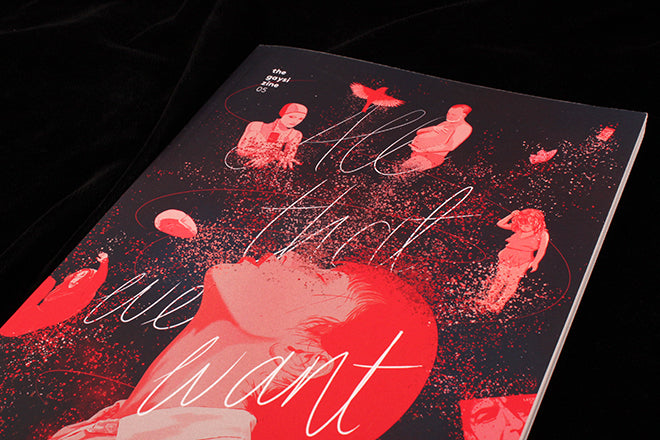
The Gaysi Zine, 5
Language is tricky when it comes to queer politics and narratives, as it creates categorization. It can be hard to find the right words to describe a spectrum of desires and identities, and magazines that talk about sex often struggle with this. The most LGBTQ+ positive titles that I’ve seen often resort to illustration to depict a range of experiences – Ladybeard’s ambitious first issue memorably made use of bright, confrontational and bold sexual imagery.
Now we see this again from India’s LGBTQ+ The Gaysi Zine (which in size and design is far more magazine than zine). The title, onto its fifth issue, aims to reach people living in smaller cities across India that don’t have access to queer events, using cartoons and graphic art to depict the narratives of like-minded individuals. As the editors write: “Our stories will be written for those who still believe that they are the only ones who are different.”
Although I don’t find the illustration as eye-catching as in Ladybeard, the same effect still holds: at times, the reader can see themselves in what’s being represented because imagery is abstracted yet it also retains a human sensibility. See below, for example (an illustration accompanying an article on how to give and receive multiple orgasms): the colours blur any obvious sense of race or colour, the bodies are obviously nude yet don’t proscribe to the stereotypes of traditional pornography (which might put off or alienate certain readers), but the drawing is also fleshy and playful so feels organic and human. There’s no sense of an objectified body or a particular gaze involved, but crucially the drawing also doesn’t feel clinical and like a chart you’d find in the doctor’s office. The abstraction and subtlety inherent in illustration allows space for the erotic, which often thrives on what’s not said instead of what’s explicit.
We’re highlighting The Gaysi Zine as our magazine of the week because art directors and editorial designers need to be conscious of how they depict sexual experience in magazines. This title from India suggests a way of thinking when you’re commissioning artwork to do with sex.
It’s also our magazine of the week because, although titles like Ladybeard, Girls Like Us and Krass subvert the traditional content you find in a glossy magazine, I’ve not yet seen an indie title offering and subverting the kinds of ‘sex guides’ you find in things like Cosmo but without a damaging tone and for an LGBTQ+ readership. The Gaysi Zine subverts the guide completely, like with this (illustrated) how-to for scissoring:
Illustration also does well to communicate the personal. As The Gaysi Zine editor Priya Gangwani notes: “Comics, graphic stories and illustration help avoid the barriers of language beautifully. They jump right out at you and grab you. The visuals make the narrative more human, and create a wonderful possibility for the readers to connect.” Some pages of the publication are entirely dedicated to comics (below), and this reminds me of resent comics newspaper Resist! (released in tandem with the women’s marches, co-edited by The New Yorker’s art director François Mouly).
The magazine is especially progressive in the political context of India, where desire and sexuality is regulated by law and institutional power (this is unpacked in detail through personal accounts in the publication). “The queer voice is louder and more visible than ever before though,” says editor Priya. “The authors in the magazine have taken great personal risks and consciously spoken about their queer desires and experiences of realising those desire. There are many narratives, for example, which speak not of urban gay culture but lived realities of LGBTQ+ people in rural areas and villages. The voices emphasise its connection with caste, class and politics of sexuality. I believe the LGBTQ movement in India was often critiqued for not engaging with these diverse aspects earlier, but one is noticing a big change there. Additionally, this issue dispels the myth that alternate sexual orientations and queer desires are alien to Indian culture!”






